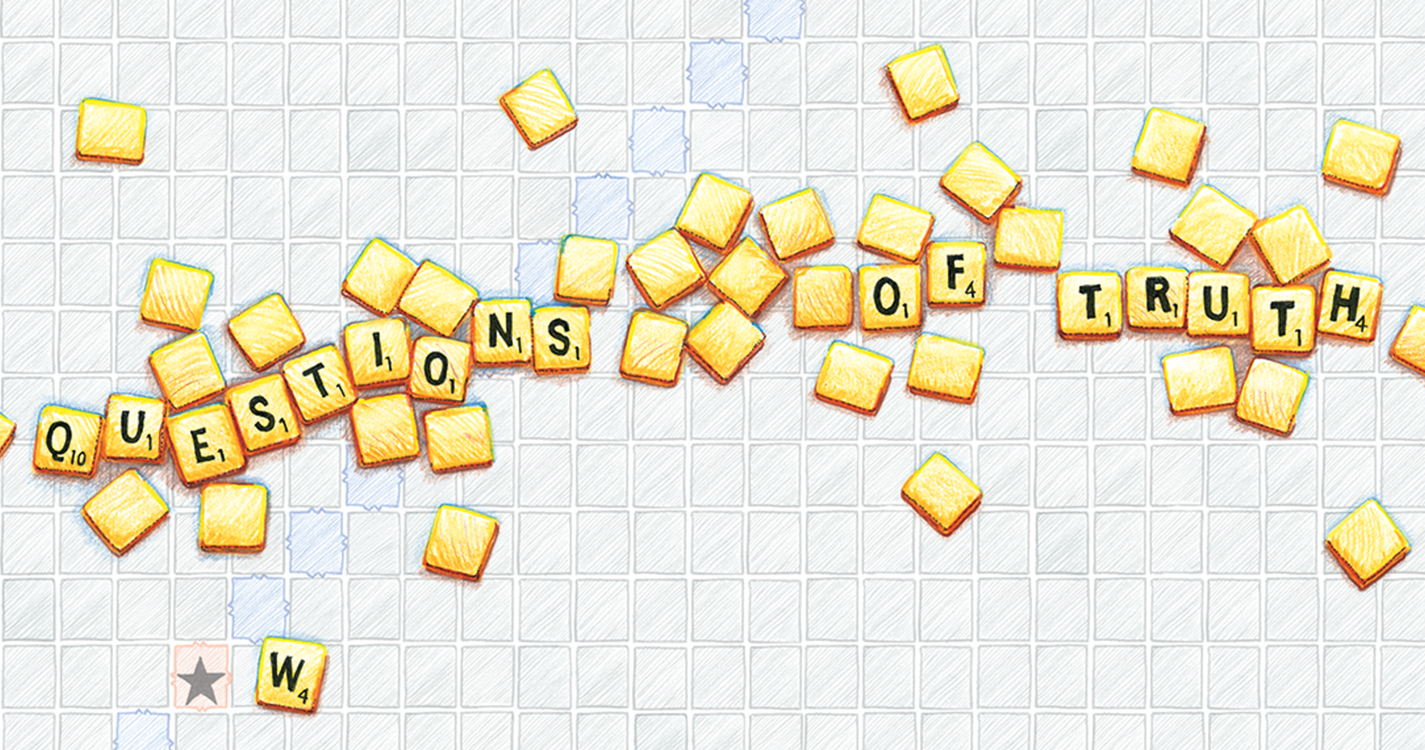We live in an information-saturated world. In a 24/7 raging torrent, news, data and opinions overwhelm us via newspaper stories, television broadcasts, tweets and internet memes.
Discerning what’s credible is harder than ever, as fiercely partisan critics cry foul with accusations of “fake news” and “alternative facts,” while wild rumors spread far and wide with the click of social media’s “Share” button. Words and facts seem to lack definite meaning or can be altered to suit our purposes.
To complicate the situation, powerful internal and external forces influence what we choose to believe.
Here, Willamette faculty and staff from a variety of disciplines offer their perspectives on these complex issues, as well as show how the university prepares students to separate fact from fiction.
When worldviews collide
Much of what we accept as true depends on how we see and interpret the world — and that’s influenced by factors such as education, religion, politics, experience, family and friends, and the media. Critics say that too many people now live in “echo chambers,” associating only with others who share their beliefs and accepting only information that reinforces their perspective.
James Friedrich, professor of psychology: Any different beliefs — on economic, cultural, religious and other matters — that people hold can work together to form a “worldview.” The aspect of one’s worldview that might shape a person’s perceptions can be determined by context. If my professional identity as a psychologist is salient, I might process and interpret information one way, but if my identity as a religious person is made salient, I might process the same information differently.
Social psychologists also talk about worldviews to refer to beliefs that give rise to people’s sense of meaning and existential purpose. In “terror management theory,” evidence suggests that when we are reminded of our own mortality, we tend to bolster and defend those beliefs that give us a sense of meaning — a sense of literal or symbolic immortality. Terror incidents can lead people to cling even more tightly to their political beliefs and values — to be more approving of others who share their beliefs and critical of those who seem to challenge their beliefs. Thus, a school shooting might be expected to bolster opposing worldviews.
Sammy Basu, professor of politics: In the U.S. today, people on both the political left and right are trapped in respective worldviews that feel viscerally real to them. Reliance on worldview explains why two people can see the same event, like a political speech, and have two completely different perspectives on it.
A given worldview is partly a function of our exposure to a culture. In Disney movies, for example, beautiful characters are typically also good ones, while villains are depicted with hook noses that conform to Semitic stereotypes of Arabs or Jews. And a lot of popular culture depicts African-American men as thugs, so it’s not surprising that many white Americans see them as threatening. It’s very hard to undo such widely reinforced cultural associations. That’s why we’re always surprised when a serial killer is conventionally good-looking — we expect them to look evil in ways that have already been created for us culturally.
This isn’t a new phenomenon. My research traces the powerful influence of the Nazi worldview on Germans during the demise of the democratic Weimar Republic and through the period leading up to World War II and the Holocaust. The German term for worldview, Weltanschauung, refers to your philosophy of life, or the mental spectacles that color everything you see. The Nazi Weltanschauung tapped into people’s biases and assumptions, validating the views of nationalists, racists and anti-Semites. Part of the puzzle about why Nazi Germany came about is that German society was very well-educated and religious. Germany had renowned universities, Nobel Prize winners and technical, artistic and scientific innovations. So it’s all the more astonishing that the country embraced a revised form of barbarism.
But Germany saw a shift in the type of thinking that gets valued, from “slow thinking,” which is reasoned and skeptical, to “fast thinking,” which feels instinctive but is actually often based on stereotypes or biases.
How we think
Whether it’s choosing a political candidate, a new car or a brand of toothpaste, our beliefs and decision-making are affected by subconscious influences and thought patterns.
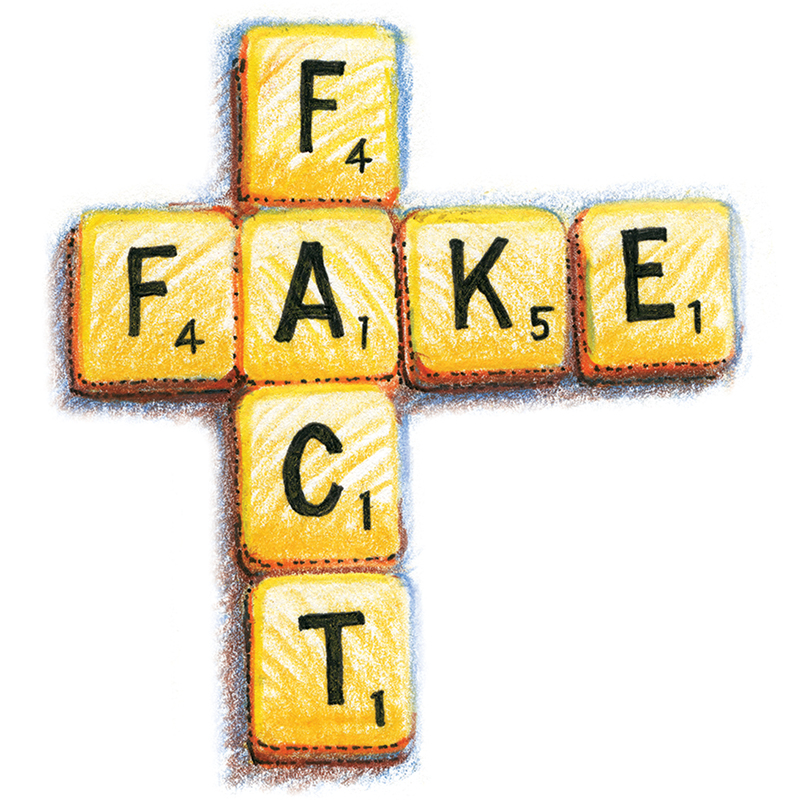
Basu: Daniel Kahneman, behavioral economist and Nobel Prize winner, developed a model of the mind consisting of System 1 and 2 thinking. System 1 or “fast thinking” is fast, emotional and instinctive. Humans have evolved to size up situations rapidly, triage and sort out matters quickly. So we’re able to ignore all the noise and distractions in a busy street in order to notice and jump out of the way of a hurtling truck. But fast thinking, which amounts to a series of pre-judgments, depends on what you’ve been exposed to through experience or cultural influences. It draws on stereotypes and can in turn produce bias. System 2 or “slow thinking” is more deliberative, reasoned and logical. Research shows that most of us engage in fast thinking, which is necessary but also imperfect — although slow thinking can be, as well.
Friedrich: When information is overwhelming, we often take “heuristic shortcuts,” focusing on only one aspect of a complex problem in order to form judgments and make decisions. It’s not a bad rule of thumb when you lack time or expertise. That’s how partisan politics works: “Do I trust Fox news or CNN?”
Also, people’s thinking and decision-making is typically organized around trying to minimize the most costly mistakes, which often means we don’t look at both sides of an issue very well. If you’re in favor of having access to guns, the most costly mistake is being defenseless in an angry, hostile world. But someone who supports gun control would see the situation differently. In their respective frameworks, both people’s decisions are not irrational.
Debra Ringold, JELD-WEN Professor of Free Enterprise and dean, Atkinson Graduate School of Management:
Information-processing is a very well-understood phenomenon that’s been studied in consumer behavior since the 1950s. The vast majority of our decisions — which brand of yogurt to buy, which grocery store to go to — are routinized and low-risk. A person has made the decision so many times and has so much firsthand trial-and-error data, it’s not cost-effective to look for new information.
Extensive problem-solving — particularly big, first-time decisions, such as buying a house — has more risk. There are different kinds of risk, including social (serving bad wine to your boss), financial, and potential harm (buying the wrong kind of bike helmet for your child). Faced with a new decision, people do a lot more research, such as talking to friends, consulting experts or reading Consumer Reports or the voter’s guide.
If people don’t search for information, it’s often because they don’t care, not because they’re ignorant. Unlike many people, I don’t believe consumers are stupid or easy to manipulate. Research, including my own into smokers’ use of tobacco and whether people read nutrition labels, shows that even people with low levels of education can process information just fine. It’s not, “Can they?”, it’s “Will they?” Smokers aren’t dumb — they know smoking could kill them. But smoking can seem a rational choice for people in certain situations. U.S. smokers are typically less well-off from a socio-economic standpoint; they have a much shorter time horizon and a very different orientation to life.
I see the plethora of information now available to people on the internet as a good thing. Better, faster information has shifted the power away from the producer to the consumer. It used to be that when one bought a car in the U.S., one had to go to a car lot. The salesman was in complete control of the information one received. Now, one can build a car on the internet with the desired specifications. The consumer now has better information than the car salesperson. That’s true for everything in the marketplace. Producers can’t corner the information market because there’s too much out there. That’s why it’s in their best interest to be open and honest. I’m a consumer advocate, so I’m all for today’s rich information environment.
Beware of biases
A host of cognitive biases — of which we’re barely conscious — also affect our views and actions. Confirmation bias leads us to seek out information that supports our preconceptions, while the backfire effect causes us to ignore contrary evidence and strengthen our original beliefs. Such ways of thinking can distort our perception of reality, as well as our judgment and decision-making.
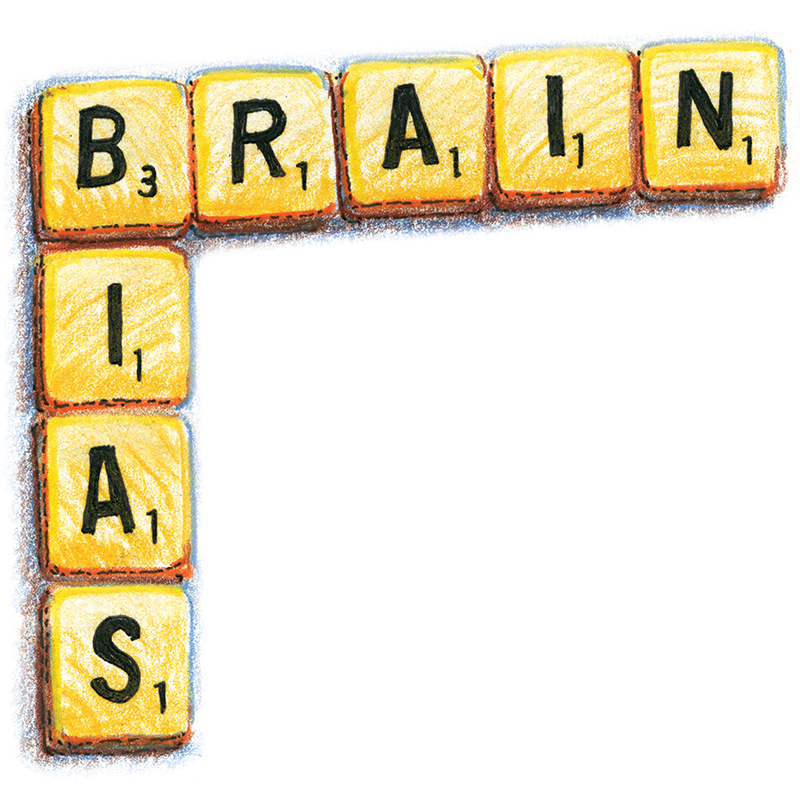
Friedrich: Research suggests we think we know our own thought processes — and are aware of our biases — better than we do. That’s misplaced confidence, as we don’t recognize our mental contamination by unwanted influences. In fact, we suffer from what’s called the illusion of introspection, believing we have more introspective access to our thought processes than we do.
When we recognize that we might be as biased as others and simply lack awareness of it, we can take appropriate precautions. That’s why I and some of my colleagues grade papers “blind ”— students put ID numbers rather than their names on papers — so our grading isn’t affected by knowing students’ identities.
Similarly, the bias blind spot refers to our tendency to see ourselves as less vulnerable to cognitive biases than other people. In one study, 100 percent of students rated themselves as better than their peers in getting along with others.
Naive realism refers to the tendency to believe that we see the world objectively; therefore, other unbiased, intelligent people will think like we do, while the people who don’t agree with us are uninformed, irrational or biased. When people “resist” our attempts to inform and educate them, we tend to attribute to them unfavorable qualities.
Bias is evident on both sides — right and left. The larger issue is we get angry and assume hostile motives on the part of people who don’t believe what we do.
Ringold: In consumer behavior literature, there’s a concept called the “third-person effect,” in which a person exposed to a persuasive communication in the mass media sees it as having a greater effect on others. Each individual reasons, “I will not be influenced, but they (the third persons) may well be persuaded.” Yet, research shows that most consumers aren’t naive about advertising — in fact, they’re quite skeptical and sophisticated. Consumers use advertising, not the other way around.
Question everything
In the light of information overload and these powerful external and internal psychological influences, how do you decide what’s true and what you believe in?
Friedrich: People hold beliefs for a variety of reasons — because they are psychologically comforting, or bolster an identity or connection to a community — and aren’t always concerned with their accuracy. We want to think of ourselves favorably — as rational, objective observers — but we’re not concerned enough about the truth to try effectively to see if we might be wrong.
As sci-fi author Philip K. Dick said, “Reality is that which, when you stop believing it, doesn’t go away.” But what we accept as evidence really differs. What sources do we trust for information? We can’t all become experts in everything, so we need to consult reliable, authoritative sources. With all the information out there, we can always find something to support whatever we think; it’s a question of whom do you trust.
Basu: One way to improve the deliberative qualities of U.S. politics and civic activity is by educating people about how implicit biases can lurk unnoticed in their fast thinking. Harvard’s Project Implicit (https://implicit.harvard.edu/implicit), for example, offers several short interactive tests based on fast thinking that help people become aware of their biases in areas such as race, gender, religion, age, weight and ability.
Kelley Strawn, associate professor of sociology: Strong social and psychological forces keep us supporting evidence that backs up who we think we already are. It takes a conscious and purposeful effort to get beyond that. You have to have the integrity to value evidence that is contrary to what you already see or believe, that challenges you to admit that sometimes the world isn’t what you want it to be. It takes mental energy, commitment and the desire to value fairness and objectivity more than being right or staying in your “group.”
In contemporary media discourse, we’ve gotten lazy about how much information we are willing to acquire, evaluate and process before we deem a question answered. We seem to value “verification” of our existing beliefs — which requires only limited information to achieve — over “reasonable truth,” which is almost never as simple as the limited presentation of issues in public media would suggest. Rather than just accepting answers uncritically, we need to develop a skeptical approach to all the information we receive.
In a liberal education, one of the most important things students learn is the difference between normative and empirical questions. Evidence can inform normative, value-based answers, but it cannot conclusively answer them. Empirical questions can be answered with visible or measurable evidence. We need to better acknowledge how information can and cannot support conclusions that we draw. That’s what liberal arts education teaches you — to be critical and to expect high-level standards for drawing conclusions. Some things are factually real and can’t be debated, e.g. 2+2=4. But is four a lot or not? That has no right answer.
Ringold: I want people to make thoughtful, well-informed decisions, but they may choose to behave differently than I would. In the case of smoking, there are people who don’t see their health as a priority. It’s about whether we trust our fellow citizens, consumers, colleagues, neighbors and children to make their own decisions in the context of their own priorities. Give people the information to make well-informed decisions and then let them make their choices.
This article was originally published in the spring 2018 issue of Willamette magazine.
How is the university preparing students to separate fact from fiction?
Preparing students to find the facts
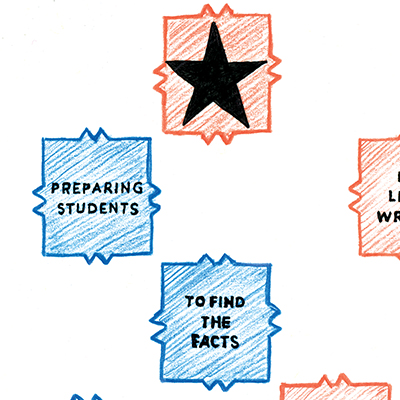
“The core mission of the Mark O. Hatfield Library instruction program is to prepare Willamette students to be successful information-seekers and critical consumers in a rapidly changing technological environment.”
That can be a challenge for a generation that grew up with the answers to everything just a Google search away. John Repplinger, science librarian at the Hatfield Library, says that even Willamette students demonstrate a range of skills in seeking and evaluating information.
“I ask where they start to look for information, and most say Google or Wikipedia,” he says, “but they’re also aware that anyone can put anything up on the internet or Facebook, and it could be fake or incorrect.”
Repplinger recommends using Google and Wikipedia responsibly and not necessarily citing them in a paper; instead, he tells students to go to the direct source of the information and “triangulate” data by consulting more than one source.
Repplinger and other librarians visit classes to raise awareness of library resources and explain the crucial differences between media such as personal blogs and journals or encyclopedia that use peer review or an editorial process for fact-checking.
“Students are constantly being bombarded with information,” Repplinger says, “and we’re here to help them process that information.”
The library also produces research guides that encourage students to ask the right questions when assessing information, whether from print newspapers, the internet, social media or email.
One digital guide, adapted from the American Press Institute, recommends six essential questions:
What’s the type of content? Is it a news story, an opinion piece or an ad?
Who’s the source? In general, reputable news organizations cite sources. If the source isn’t clear, be more skeptical.
What’s the evidence? Don’t just take someone’s word about information. What’s the evidence and how was it vetted?
Is the main point proven? Do conclusions make sense and follow logically from what’s been cited?
What’s missing? If important information is missing, or something is explained unclearly, that’s a problem.
What did I learn? Think about the media you consume, including social media or even conversation, and assess what you learned.
The library also encourages students to check their biases, consult experts and use websites such as factcheck.org, snopes.com, politifact.com, the Washington Post Fact Checker and Media Bias Fact Check.
Preparing students to persuade
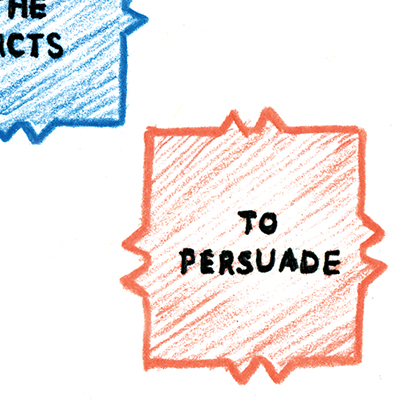
Over the course of a semester, Willamette students learn to wield — rather than be on the receiving end — of persuasive techniques used in marketing and public relations.
In the “Designing Persuasive Campaigns” class offered by Professor Courtney Dillard in the Department of Civic Communication and Media, students research, plan and create marketing campaigns for local nonprofits, small businesses and campus organizations.
Whether the aim is to recruit more volunteers or encourage someone to try a new product, students learn the most effective ways to craft and disseminate a message. After conducting research into their audience and appropriate communication channels, they analyze and apply relevant persuasive techniques, including:
Making a good argument and providing good evidence. A campaign or ad has to provide rational answers to people’s question, “Why should I?” Evidence can take the form of images, statistics or examples.
Using emotional persuasion. Motivational appeals speak to values, needs and emotions.
Providing credibility. Dillard notes, “Today, credibility is more important than ever for organizations to communicate to their stakeholders.”
Using identification. Effective campaigns find common ground with the audience, saying in essence, “I’m like you.”
Framing it. Take a complex issue, such as homelessness, and focus on one aspect.
Using language and visuals effectively. Alliteration, double entendres and creative photography help grab attention and focus the issue.
Creating a narrative. Adopt the power of storytelling, with devices such as strong heroes, a plot with a concrete beginning and ending, and a moral to the story.
By the end of the course, students have created a multi-step communication plan, as well as work samples — such as a website, brochures or social media campaign — that look good in their portfolios. Perhaps more importantly, they’ve gained an insider’s look at the power of persuasion.
Preparing students to understand data

The need to understand and use data doesn’t only happen in a math or physics class — it’s also a part of everyday life beyond college. Whether you’re checking a paystub, applying for a mortgage or deciphering a news story about a medical trial for a new drug, a grasp of numerical — or quantitative — information is essential.
“So much about basic citizenship — let alone professional skills — demands numerical literacy,” says Kelley Strawn, associate professor of sociology. “Quantitative thinking isn’t superior to other modes of thinking — it’s complementary.”
Fortunately for Willamette students, a dedicated center in Smullin Hall helps them become more comfortable with data. The Center for Qualitative Understanding, Analysis, and Design (QUAD) was founded in 2010 by psychology professor James Friedrich, who now co-directs it with Strawn. The center also provides support for classes and for faculty doing research.
“Quantitative literacy extends beyond calculations,” says Friedrich. “Understanding that small samples in a study may be unrepresentative either by chance or bias, that predictions are imperfect, and that certain ways of collecting data allow inferences only about association and not causation — these are among the many “study design” elements of thinking about numbers and data that form the basis of quantitative literacy.”
Quantitative and qualitative approaches ask fundamentally different questions. The quantitative approach measures information, while the qualitative approach describes and helps explore different options.
With the help of the center’s undergraduate research assistants, students from across academic disciplines can learn how to better collect, analyze and critically evaluate quantitative information for their projects, papers or assignments. A history student might need help deciphering voter patterns, an economics student might want food production statistics and a chemistry major might need assistance testing a hypothesis.
“In this age of digital information, the ability to use quantitative information is fundamental to what we should define as a liberal arts education,” says Strawn. “Students need to be ‘words’ and ‘numbers’ people.”
Friedrich agrees, saying, “Especially at a time when statistics and other ‘evidence’ flow freely through social media and the web, being motivated and able to assess the quality of information and the justification for evidence-based claims is critical.”
Preparing students for legal writing
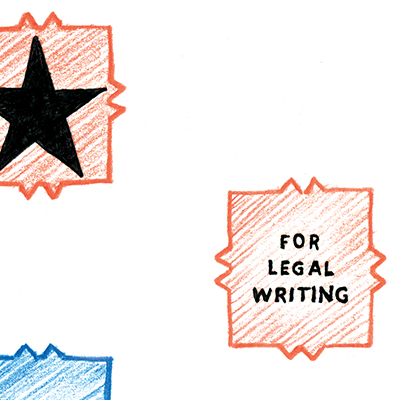
Laura Appleman is used to public misperceptions about legal proceedings. But perhaps the most persistent myth is that all criminal cases go to trial. In fact, 98 percent of cases end up with a plea bargain.
“The suspect in the recent Parkland, Florida, shooting would like to entertain a plea deal to avoid the death penalty. Even fraudster Bernie Madoff got a plea bargain,” notes Appleman, a former public defender and now a professor in the Willamette University College of Law. “Jury trials are a classic paradigm, but we have few of them. For lawyers, it’s more a question of convincing a judge at an earlier or later stage of criminal indictment.”
Such attempts to persuade a judge are usually done in writing. “Most of being a lawyer is doing legal writing,” says Appleman, “not being Perry Mason in a courtroom.”
That’s why a key element of Willamette law students’ education is research and writing. In order to graduate, law students have to successfully complete both a research writing requirement and a professional skills requirement. So, they learn to analyze and reason using statutes, court rules and judicial opinions, communicating their legal analysis clearly and effectively in documents such as memorandums and trial briefs.
“The key thing to being a good lawyer is being a good writer,” says Appleman. “That’s an approach we share with the College of Liberal Arts. Being able to write persuasively is absolutely critical.”

